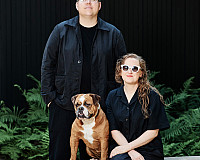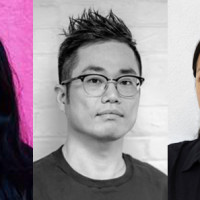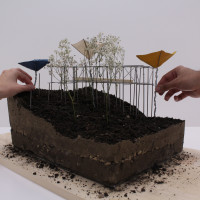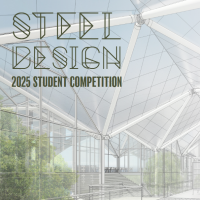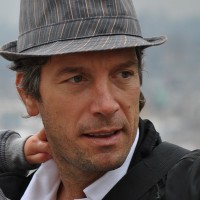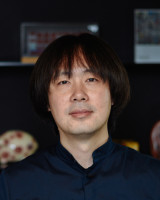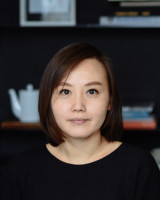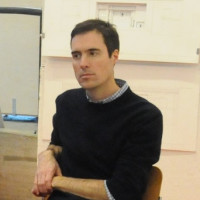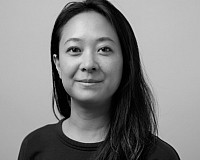Architecture Convocation - May 11, 2019
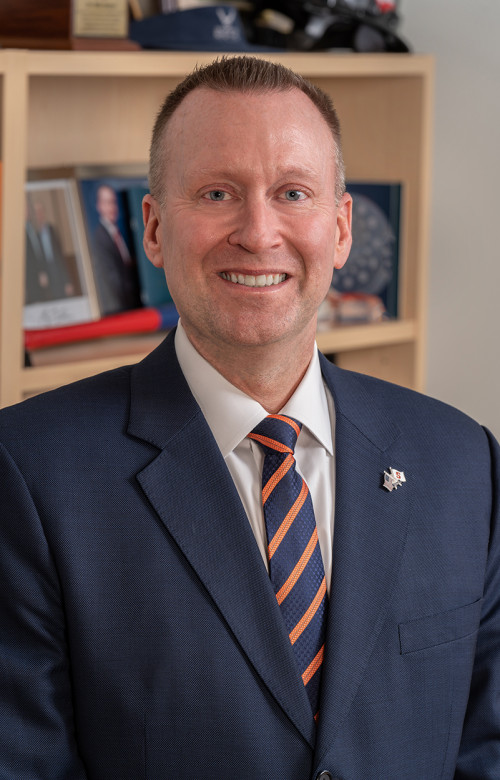
Thank you for the opportunity to address you today – on this day – a day that marks a truly remarkable milestone of your life’s journey.
I’m honored and humbled by the invitation.
Now that said, I have to admit I was a bit surprised when my friend, Dean Michael Speaks, offered me the opportunity to speak today.
I say that to call out the elephant in the room right up front:
I’m not an architect!
In fact, my architectural shortcomings were first on display to the world very early in life. One of my most memorable childhood adventures came at the age of 10, when I ended up in the emergency room with a concussion, after a fort I tried to build in my back yard, out of old lumber I found in our garage, collapsed on top of me and knocked me out cold.
I share that story to level-set your expectations…
When I pressed Dean Speaks as to why he wanted me to address you today, he said quite matter-of-factly:
“You’ve been leading an effort to build a new campus facility for the past three years, I certainly hope you learned something!”
He then turned around and walked away – that was it. Some of you students – or even faculty – may have experienced a moment like that with Michael yourselves!
It’s true. For the better part of the past three years, I’ve been deeply engaged in a truly exciting project here at Syracuse University: The design and construction of the Syracuse University National Veterans Resource Center.
The experience has been both amazing, and also at times overwhelming.
We held an international design competition for the project, and brought in the Director of the Pritzker Prize, the Editor of Architectural Record, and some of our most accomplished architecture school alums – people like Steve Einhorn – and also current Syracuse University architecture students, to organize and lead the selection process.
The firms that competed were some of the most accomplished in the world.
In fact, at the time our design competition was underway, the competition for the commission to design the Obama Presidential Library in Chicago was also in progress. The three firms Syracuse University selected as finalist to design the NVRC, were also among the finalists competing for the Obama Presidential Library.
All of this is to say that it’s true: before this experience, the sum total of my architectural knowledge was limited to my backyard fort-building adventures. Consequently, what I’ve learned about architecture and architects, as a result of the NVRC project, has been significant to say the least.
In that regard, and in an unanticipated way, Michael’s speaking invitation has been a gift of sorts.
I say that because I’m not someone who tends to engage in a lot of ‘self-reflection.’ I’m not necessarily proud of that fact, but if I’m being entirely honest, I think those who know me well would attest to the fact that I’m someone who is naturally wired to focus – sometimes to a fault – on what’s ahead, as opposed to what might be depicted in my own rear-view mirror.
However, reflecting on all that I’ve learned – all those I have engaged with – and all those who will benefit from our efforts to bring the National Veterans Resource Center to life – that exercise has proven almost therapeutic for me, in a way that I didn’t necessarily anticipate.
I’d like to explain, and to do so, start out by offering an insight that is wholly unoriginal and probably uninspiring.
The world is a diverse place. Our communities – however defined – are composed of individuals who themselves are defined uniquely, by divergent and convergent experiences, values, views, and perspectives.
As I suggested, this is an insight that while true and important, is also by itself static and without prescriptive consequence for informing how humans engage the world.
However, I’d like to attempt to recast this insight in the context of Michael’s suggestion that “hopefully I learned something” as a consequence of my experience on the NVRC project.
By doing so, I hope to suggest to all of you, a lens through which to frame how and why your time at Syracuse University, and uniquely as students at the School of Architecture, has uniquely positioned you to powerfully impact your communities, your profession, and the world – when you leave this place, degree in hand.
This is my hope, because upon reflection, I realize that the most significant learning for me – working closely with people like you – had nothing to do with what architects taught me about loads, or curtain walls, or rain screens, or footings, or trusses, or concrete, or steel.
Instead what I learned from architects – uniquely and maybe really the first time – is to appreciate how and why our sameness and our difference collide in physical spaces and tangible places.
I learned from architects about the significance of a space’s capacity and willingness to include – or not – the people that are meant – or not – to occupy that place.
That is to say, I learned from architects how and why the physical spaces we live in, work in, and learn in – represent an opportunity to build a community, to shape who we are, who we want to be, and to bridge differences in a way that cultivates knowing.
That is to say, I learned from architects that the thoughtful consideration of places and spaces, is uniquely positioned to enact the promise and potential associated with embracing divergent and convergent experiences, values, views, and perspectives.
If you bear with me, I’d like to illustrate the significance of this learning for me – and more importantly, for the women, men, and families that the National Veterans Resource Center will impact – by way of a story about two people I met once on an airplane.
It was shortly before we announced the design competition for the NVRC, and I was flying back to Syracuse from a fundraising trip to the west coast.
I boarded the flight, took my seat, and as I was drifting off to sleep when the pilot came on the PA system. I hadn’t noticed, but sitting just a few rows in front of me were two young soldiers. Over the PA system, the pilot asked the passengers to join him in thanking these two for their service. The passengers gave them a polite round of applause – a handshake from those sitting close enough to reach the young men.
During all of this, I happened to take particular notice how the woman sitting next to me was making quite a show of her support for these two soldiers…clapping and whistling. It struck me that maybe this show was more about her, than it was about acknowledging those two soldiers.
Now, I’m a social scientist, and at times like this I’ve been known to, let’s say, perform impromptu social experiments. So, while I normally despise talking to anyone on an airplane, I decided I was going to engage this woman in a conversation.
I shared with her that I was a military veteran myself, and that today I direct an academic institute at Syracuse University, focused on addressing the issues and concerns of the nation’s veterans and their families.
In turn, she enthusiastically shared with me how she always thanks those in uniform for their service, and encourages her friends to do the same.
We had a pleasant chat, at least until I started to shift the conversation to some of the challenges, which today confront some of America’s veterans and their families.
For example, I told her how far too many veterans of the post-9/11 generation – especially the youngest – struggle to find a job after they leave the military.
I told her that could be because almost 30% leave the military with a disability stemming from their service.
On the spot, I could see her growing more and more uncomfortable. And then I hit her with the suicides.
I told her that, on average, more than 20 veterans take their own lives each day in this country – that is a suicide every 80 minutes. I told her that the truth is, during recent years, many more veterans have died by their own hand, than have been killed in places like Iraq and Afghanistan.
And that’s exactly when our conversation ended. She looked at me and said, “I just can’t believe it. None of that can be true. Didn’t you see us all clap for those soldiers? America supports its veterans.”
At that point she pulled out her iPad, put on her headphones, and proceeded to turn her attention to a re-run of Home & Garden TV.
I thought maybe I had gone too far. But then at that moment, a young man sitting on the other side of the aisle – who apparently overheard this entire conversation – tapped me on the shoulder. He looked at me square in the eye, stuck out his hand, and simply said, “Thanks.”
It turns out that his name was Tim, and Tim was a veteran.
Tim volunteered and enlisted in the Marine Corps when he was 18. He served four years, and spent three of those years in either Iraq or Afghanistan. He got out of the Marine Corps just six-months ago – now 22 years old – and his plan was to go to school and get his degree.
He seemed ashamed to tell me that he only lasted 2 months on campus. He said he just didn’t fit in. He’s been trying to find a job, but no luck so far, and he’s hoping the doctors at the VA can figure out how to stop the ringing in his ears, so he can get more than a few hours of sleep each night.
Now at this point I had been working on behalf of veterans and their families for almost a decade, so none of what Tim said was even remotely surprising to me.
However, what Tim said next that hit me like a punch in the gut.
As this young Marine’s eyes started to teared-up, he said, “Mike, worse than all of that, since I’ve been home, I feel alone and anonymous.”
Anonymous…reflect on that for a minute.
Now home, among the very people who sent him to war, Tim feels anonymous.
I looked over at the woman next to me, now lost in her reality TV, and the cultural and physical contrast that I experienced at that moment – the distance between these two – it was enough to give me goose bumps.
On my right was a woman, who was profoundly ignorant of the issues and challenges facing the young man on my left – issues and challenges that (by the way) stemmed directly from his service on her behalf.
Here was a young combat veteran who’s telling me that – in the context of all the hardship he has endured, and that he will endure – that what weighs on him most now that he’s home, is that he feels anonymous.
It is important that I explain why Tim feels anonymous:
- Tim feels anonymous, because unlike any other war in our country’s history, the burden of the wars in Iraq and Afghanistan have been shouldered by a tiny minority of Americans…less than 1% of the population.
- And for that reason, odds are that Tim – or someone like Tim – is not the son, husband, brother, neighbor, classmate, teammate, or even your friend to anyone at work, or anyone on any college campus, or anyone in this room.
- And for that reason – like that lady sitting next to me on the plane – too many of us haven’t had the opportunity to know Tim, and through knowing Tim, come to deeply understand the singularly unique and sometimes morally burdensome challenges associated with – as a an 18 year old kid – being sent off to find, fight, and kill this countries enemies.
- And for that reason, because we don’t know Tim, not enough of us are meaningfully invested in Tim’s future.
- And for that reason, Tim feels – and in many ways is – anonymous while among us.
So at this point you might be asking yourself, what does this story have to do with architecture?
Reasonable question.
At the time I shared this story with the architects involved with the NVRC project, I wasn’t convinced this story had anything at all to do with architecture.
Those architects, however, had a very different view.
For them, Tim – Tim’s story – would become the foundational narrative that informed and animated the vision for the design of the National Veterans Resource Center.
A vision for places and spaces, conceived as an opportunity to build community and to create collisions between divergent and convergent experiences, values, and lives.
A vision for places and spaces, where opportunities for those who don’t know Tim, can navigate to knowing Tim – and those like Tim.
- Because of an architect, this building will tell a story.
- Because of an architect, it’s uniquely Tim’s story.
- And uniquely my story.
- And maybe your mother’s story.
- Or maybe your grandfather’s story.
- All, of this, because of an Architect.
Earlier I shared that I learned from architects the significance of a space’s willingness to include or not – the people that move through or exist there. This willingness to include, encourage, and engage – or not – is defined by the architect’s vision.
What a gift, and what a burden.
An architect’s vision for the NVRC was driven by Tim’s story. It was driven by the idea that we must create a space that physically includes, and embodies the stories of those who elsewhere on campus or in the world – may feel, or in fact be, anonymous while among us.
The power of architects to do this is substantial.
The responsibility to do this is even greater.
As architects, you will have the opportunity to inform and define the social and cultural experiences of others. As you make these decisions – it is paramount that at the forefront of your mind is empathy, and a willingness to understand how others interact with the spaces you will be charged with creating.
You must be willing learn and leverage empathy in this regard. You must be willing to think about how a space plays a role in including others, elevating others, or possibly marginalizing others. In any of these instances, what’s important to acknowledge is that the space you create will tell that story.
As I said. I am not an architect. But the lessons I’ve learned during this process are ones I propose to all of you – as a charge, and as your mission.
Be relentlessly focused on a space’s capacity to be a place where our sameness and differences naturally collide.
Be relentlessly focused on even the smallest details, those nooks and crannies that give spaces and places the power to tell stories that connect people.
It’s true that Syracuse University has equipped you with all the technical skills necessary to create spaces that will resemble lasting commitments to important things.
But even more importantly, I know that Syracuse University is a place that has also equipped you with the experiences, the perspectives, and the humanity positioned to empower you with the willingness and capacity to create places and spaces that lift people up, and that connect the otherwise disconnected.
If you do this well, your will earn the privilege of telling their stories.
Important stories.
Like Tim’s story.
So on behalf of Tim,
And all the people whose stories you will one day tell…
I say thank you and congratulations!
J. Michael Haynie, Ph.D.
Vice Chancellor for Strategic Initiatives and Innovation; Barnes Professor of Entrepreneurship; IVMF Founder & Executive Director

